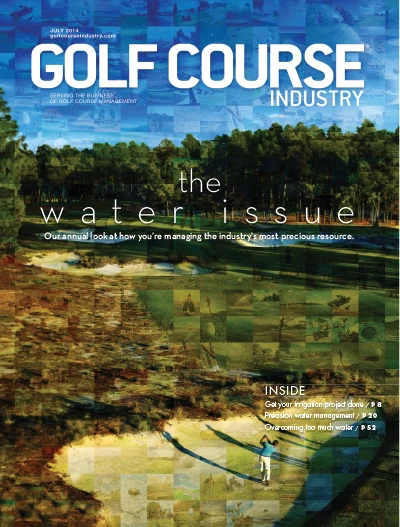 Monroe Miller Monroe Miller |
It is a foolish discussion that leads to foolish arguments: What’s the most important factor in golf turf management? You’ll find advocates for disease control. Others will argue improvements in mowing equipment have made turf machinery the most important. Plant nutrition will have its proponents, as will PGRs, grass varieties or dozens of other factors. I cast my opinion with those who believe water is the most important factor in healthy and quality turf. For most superintendents, this may imply course irrigation is the bottom line for consistent playing conditions. My tenure in golf gives me a broad view of how far we have come. When I started my career courses were watering greens and tees with either hose-and-roller base sprinklers or quick-coupler valves and sprinklers on keys. Both were inaccurate and inefficient. Younger superintendents cannot imagine stringing out and rolling up a mile or so of hose every night. The biggest issue was finding and training a dependable night waterman. The wear-and-tear on watering vehicles was costly. For the night waterman, storms were scary. If fairways were irrigated, it was with implements like Rain Trains or with center-line, quick-coupler valve systems. The one I inherited had valves 100 feet apart, leaving huge scallops that were either ignored or required endless hand watering. A nearby course had 80-foot spacing and significant wet areas around each valve. I found it interesting that during a televised discussion of the U.S. Open we learned that Bill Coore and Ben Crenshaw removed hundreds of irrigation heads from Pinehurst No. 2 and returned to single-row irrigation on the fairways; it was one of several factors they used to return the course to its original design and the way it played 75 years ago. Throughout the tournament you could see the scallops, dry edges and uneven coverage. What a perfect example of progress in irrigation. Imagine the elation when we installed a double row Network 8000, only the second in Wisconsin. Nozzle selection, precise timing, two-speed and part-circle heads – it was a sea change. Since that installation in 1988, the only parts remaining are the piping and the wiring. Everything else has been upgraded. Pump stations have made significant improvements, too. From water probes and mercury switches to variable frequency systems, the problems have diminished and the accuracy improved exponentially. Page through any turf journal and you will see ads and articles dealing with irrigation equipment, manufacturers and distributors. It is powerful evidence as to how important water is to turf. The massive and disastrous drought afflicting vast areas of our country in recent years leads many to assume that conversations about water issues are really about irrigation. Personally, I include drainage as a factor as important as turf irrigation. For example, for the 40 years I worked on golf courses, only three years could qualify as drought years. Also, our course was on the shore of a 10,000-acre lake. We had riparian rights and had a DNR permit to use that water for irrigation. In the course’s nearly 100-year history, the level hasn’t dropped to the shutoff level for irrigation. Also, our town receives almost 35 inches of precipitation each year, and we receive precipitation of some description on 120 days of the year. The hottest all-time temperature was 104 degrees, and we only cross the 90-degree threshold about a dozen times each year. Add to that the courses built on poorly drained soils and disrupted soils, and you can understand why drainage is so important. I learned the most important issues in golf course design were: Drainage; drainage; and drainage. In the early days of golf course construction, it was understood that internal drainage developed over centuries. Therefore, only a small fraction of the soil moved today was moved then. And on those days when big storms roll through and heavy rain comes all at once, surface drainage keeps it out of the lake, off neighbors’ property and over to low areas on the golf course. Golf’s forefathers understood what I hope isn’t forgotten amidst all the excitement of irrigation technology. Irrigation and drainage – they go hand-in-hand.
Monroe Miller retired after 36 years as superintendent at Blackhawk CC in Madison, Wis. He is a recipient of the 2004 USGA Green Section Award, the 2009 GCSAA Col. John Morley DSA Award, and is the only superintendent in the Wisconsin Golf Hall of Fame. Reach him at groots@charter.net. |
Get curated news on YOUR industry.
Enter your email to receive our newsletters.
Explore the July 2014 Issue
Check out more from this issue and find your next story to read.
Latest from Golf Course Industry
- PBI-Gordon Company hires marketing manager Jared Hoyle
- Mountain Sky Guest Ranch announces bunker enhancement project
- GCSAA names Joshua Tapp director of environmental programs
- AQUA-AID Solutions bolsters Sunshine State presence
- Escalante Golf acquires secluded Illinois course
- Tartan Talks 105: Nathan Crace and Todd Quitno
- Disease Discussion 24: Let the turf talk to you
- From the publisher’s pen: Foggy intrigue





